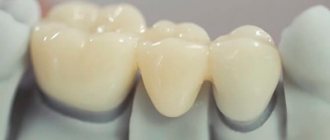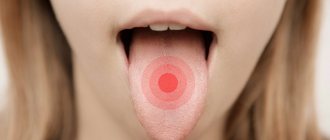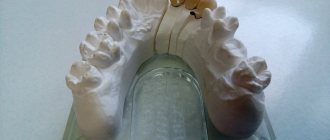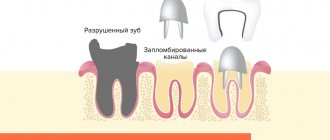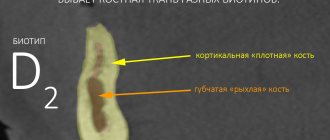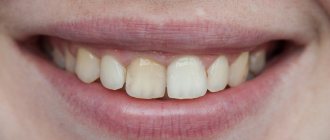Causes How to fix?
How to increase the service life of a prosthesis Poor environment, poor nutrition, and polluted water lead to more and more people suffering from diseases of the teeth and oral cavity. In some cases, teeth cannot be saved. But the possibilities of modern prosthetics make it possible to restore your smile and self-confidence. Provided that the denture does not fly off. And this, unfortunately, happens.
Depending on whether some teeth are preserved or completely lost, complete and partial removable dentures are installed. Complete dentures are supported by:
- Cohesion of wet surfaces - adhesion
- Relief of the oral cavity: tubercles, protruding parts and depressions (retention)
- Valve fixation. Due to the difference in pressure, a vacuum forms under the restoration, holding it in place.
Why is it more difficult to get used to a complete removable denture on the lower jaw?
The upper complete removable denture, due to its shape and anatomical features of the upper jaw, sticks to the palate and holds quite well.
People have little trouble fixing it. The greatest difficulty in getting used to is the lower complete removable denture. This is due to the fact that when not a single tooth is missing, there is a difficult fixation of this prosthesis on the lower jaw. The lower complete removable denture cannot adhere to the lower jaw, it simply lies on it.
The situation is further aggravated by the fact that the tongue is attached to the lower jaw. As the jaw moves, this powerful muscle begins to move and releases the denture. The masticatory muscles are also attached to the lower jaw, which at the moment of chewing also begin to move, move the mucous membrane and try to remove the denture. In addition, the anatomical complexity of the mucous membrane on the lower jaw complicates the adaptation and fixation of a removable denture, since it is looser, softer and less attached to the bone compared to the upper jaw.
Troubleshooting methods
The list of techniques used to ensure the seating density of the replacement structure includes:
- Adjustment of configuration and replacement of fixing elements;
- Use of adhesives;
- Implantation of mini-implants;
- Complete replacement of the prosthesis.
In some cases, it is possible to avoid adjusting the prosthesis - to do this, it is necessary to teach the patient how to control the masticatory muscles. Proper biting and chewing of food ensures even distribution of the load, which eliminates the possibility of displacement of the replacement structure.
What to do if the denture rubs the gums?
If the prosthesis begins to rub the gums, pain and discomfort begin, you need to evaluate how intense this pain reaction is.
If these are minor pain sensations: it hurts a little, aches a little, tingles, then you can wait 2-3 days, using pharmacy ointments for pain.
If these sensations do not go away within 2-3 days, or the pain intensifies, then you need to go to the doctor who made this removable denture. The doctor will look at your jaw and in those places where the prosthesis presses too much, he will adjust it and sharpen it so that in this place the prosthesis does not press through the mucous membrane. There may be one or several such corrections, depending on the sensitivity of the patient’s mucosa. Over time, these corrections stretch from one to two to three weeks.
What to do when a dental bridge has already fallen off?
The best way out of this situation is to see a dentist as soon as possible. When visiting a doctor, you must bring your saved prosthesis, even if it is cracked in half. You should not repair the bridge yourself using various adhesives that can damage healthy teeth.
If the bridge did not break when it fell out, it will be put back in place using dental cement. If the denture breaks, an impression of the patient's teeth will be taken and a dental technician will make a new denture, which will require additional costs and a long time.
Correction, relining of a removable denture when the gums are rubbing.
If chafing from a new denture does not go away and you decide to see a doctor, then it is necessary that these chafing be visible to the doctor. That is, if you removed the denture and did not wear it for some time, then before visiting the doctor you need to wear the denture for several hours so that all the rubbing, redness, and calluses on the gums appear again, and the doctor can see the places on the gums that the denture is pressing through. Otherwise, if the doctor does not see anything on the gum, the denture is sawed at random and a lot of excess is cut off, which further worsens the fixation of the complete removable denture, and food will accumulate and get stuck in these places when eating.
Reasons why a dental bridge may fall off
The integrity of the dental bridge is influenced by the following factors:
- The bridge was made to inaccurate measurements. Dentists believe that a bridge can only be made for five crowns and no more, otherwise the bridge design becomes unreliable.
- If the neighboring teeth that support the bridge are poorly prepared for prosthetics, this can also cause the bridge to fly off.
- Crowns for supporting teeth must be made of high-quality material, and they must be fixed with high-quality dental cement.
- Improper oral and dental hygiene. To keep your artificial teeth clean, you should have your teeth professionally cleaned twice a year. If this is not done, the period of wearing dentures will be greatly reduced.
How can I make it easier for myself to adapt and get used to a lower removable denture?
If the denture is very poorly fixed on the jaw and dangles, if the jaw is flat and there is nothing for the denture to grab onto, then you can use special means to improve the fixation of the removable denture. These are various adhesives and gaskets.
Many patients do not wear their dentures all the time, and they especially often take them out at night. There is no such need; to get used to it, it is better to wear the prosthesis around the clock. Nothing bad can happen at night, the prosthesis simply cannot be swallowed or choked on, it is much larger than a person’s throat. In the worst case scenario, you may wake up and the denture is not in your mouth, but lying next to you on the pillow. You shouldn’t take breaks during the day either, even if your jaw and gums are tired, you want to rest. At this moment, when you remove the prosthesis, the jaw and mucous membranes become unaccustomed to the prosthesis, and when an hour later you put it on again, everything starts all over again. At the same time, the jaw and mucous membranes become even more tired. Often, patients who take breaks simply stop wearing such a prosthesis after a few days.
Reasons for unsatisfactory fastening
In order for the patient to adapt to the new structures as quickly as possible, experts recommend not removing them even during sleep (despite pain and discomfort in the gum area). As a rule, adaptation to the prosthesis and a tight fit to the crest of the alveoli is achieved 3 weeks after installation.
Sometimes cases occur when a tightly fixed product begins to wobble. The reason of that:
- Unprofessional adjustment of the base - the lower dentition often suffers. This is due to the fact that the jaw is involved in speaking and chewing food. Due to constant mobility, the structure may move from its original location.
- Lack of supporting teeth - if there is one supporting tooth, the fixation weakens over time.
- Anatomical and physiological features of the dentofacial apparatus - incorrect arrangement of teeth, a small amount of bone tissue, etc.
- Incorrectly selected method of fastening - methods such as clasps (wire hooks), screw elements, magnets, attachments (locks), pelots are used for fixation. For each patient, the type of fastening is selected according to individual parameters.
- Looseness of the supporting teeth is observed both before and after fixation of the prosthesis. At the same time, not only molars, but also bridge-like products can become loose. The reason for this is the destruction of the fastening cement.
How to manage without dentures?
Alas, you cannot do without prosthetics. The loss of even one tooth disrupts the harmony in the oral cavity. In place of a lost tooth, the skin becomes less elastic, the correct oval of the face is lost over time, and signs of aging appear. The load on the remaining teeth increases. The jaw bone becomes thinner and the gum structure changes.
After tooth extraction, less blood flows into this area of tissue, and the number of blood vessels in the area where the tooth is missing decreases. As a result, the structure of the jaw bone is disrupted. All these processes then lead to displacement of the dentition, to an incorrect bite. And this, in turn, affects the quality of chewing food and disrupts the digestion process.
Even a person’s speech is impaired. Due to the absence of individual teeth, it is impossible to pronounce some sounds correctly. Especially if the problem affects the front teeth. Moreover, the absence of the front row of teeth leads to changes in the nasolabial fold. It lengthens, the corners of the mouth droop, and the person begins to look older than his age.
Reasons for detaching the crown from the implant
The implant system consists of several components. In particular, it includes a titanium rod-screw and an abutment - an adapter on which the crown is fixed. All these elements of an artificial tooth are securely connected to each other and are normally motionless. But sometimes the prosthetic structure first begins to wobble and then falls out. It also happens that the crown suddenly falls off, exposing the metal element underneath. The reasons for this incident could be:
- Poor quality fixation of the prosthesis. The crown is attached to the abutment using a special cement composition. Violations of technology can lead to detachment of the prosthesis.
- Unscrewing the crown-abutment connection. If screw fixation of the prosthesis was used, over time it may become loose and become mobile or fly off.
- Incorrect installation. When choosing an abutment and making a prosthesis, the anatomical features of the patient’s oral cavity must be taken into account. If this is not the case, problems will appear over time.
- Excessive load on the prosthesis. Frequent chewing of too hard and sticky foods, cracking nuts, and the habit of gnawing on hard objects can also lead to disruption of the connection between the crown and the implant.
Treatment methods
You can soothe inflamed areas of soft tissue with the help of medicinal oils, for example, rose hips or sea buckthorn. Pharmacies also sell special collagen plates and pads, which are designed specifically to protect the mucosa and facilitate adaptation to removable orthopedic structures. Creams and gels for stimulating tissue healing have proven themselves to be excellent in this regard. But in any case, with the problem, you need to contact your attending physician, who will be able to determine the tactics of further treatment and understand whether the design needs to be adjusted or the use of medications will be sufficient.
Relining the denture In the process of constantly wearing a removable denture, the bone tissue of the jaws gradually atrophies, which causes the gums to recede. As a result, the design may cause some discomfort, but the procedure of relining the prosthesis, that is, its correction, will help to cope with the problem. True, it will have to be carried out regularly, since the level of the alveolar ridge will constantly change.
Price:
from 1000 rubles more about the solution
Making a new prosthesis If the orthopedic structure begins to rub due to breakage, the creation and installation of a new one will be required. Manufacturing can take from 3-4 days to a couple of weeks. During fitting, it is important for the patient to carefully listen to his feelings, as well as evaluate how comfortable the new design is. If discomfort is felt, the prosthesis should be sent for re-adjustment and adjustment to the desired parameters.
Price:
from 15,000 rubles more about the solution
Implantation with immediate loading Modern one-stage methods of dental implantation require immediate loading with a prosthesis. In addition, these treatment protocols in most cases make it possible to avoid bone grafting or sinus lifting in the upper jaw. Complex dental restoration with complete or almost complete edentia can be carried out using 3, 4, 6 or even 12 implants. In any case, the prosthesis is installed on the 3rd day maximum, which allows the patient to fully smile and eat almost immediately. Unlike removable prosthetics, a design supported by implants lasts longer, it is much more comfortable, and does not cause discomfort or chafing of the mucous membrane at all.
Price:
from 180,000 rubles / 1 jaw more about the solution

